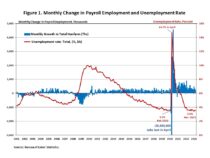Job growth slowed in March, along with higher interest rates and increased economic uncertainty. After a revised 326,000 job gain in February, total nonfarm payroll employment increased by 236,000 in March, and the unemployment rate declined to 3.5% from 3.6% in February. Average hourly earnings have increased by 4.2% on a year-over-year basis. It marks the lowest wage gain since June 2021, suggesting inflationary pressures are easing.
Construction industry employment (both residential and non-residential) totaled 7.9 million and exceeds its February 2020 level. Both residential construction (-7,000) and non-residential construction employment (-1,800) saw job losses in March. Residential construction employment exceeds its level in February 2020, while all non-residential construction jobs lost in March and April 2020 have now been recovered.

Total nonfarm payroll employment increased by 236,000 in March, following a gain of 326,000 in February, as reported in the Employment Situation Summary. It marks the slowest monthly gain in more than two years. The estimates for the previous two months were revised. The estimate for January was revised down by 32,000 from +504,000 to +472,000, while the February increase was revised up by 15,000, from +311,000 to +326,000. Despite tight monetary policy, over 4.6 million jobs have been created since March 2022, when the Fed enacted the first interest rate hike.
The unemployment rate edged down to 3.5% in March. The number of employed persons increased by 577,000, while the number of unemployed persons decreased by 97,000.
Meanwhile, the labor force participation rate, the proportion of the population either looking for a job or already holding a job, edged up 0.1 percentage point to 62.6% in March, reflecting both an increase in the number of persons in the labor force (+480,000) and a decrease in the number of persons not in the labor force (-320,000). Moreover, the labor force participation rate for people who aged between 25 and 54 remained at 83.1%. While the overall labor force participation rate is still below its pre-pandemic levels at the beginning of 2020, the rate for people who aged between 25 and 54 is back to the pre-pandemic level.

For industry sectors, employment in leisure and hospitality (+72,000), government (+47,000), professional and business services (+39,000), and health care (+34,000) continued to trend up in March.
Employment in the overall construction sector decreased by 9,000 in March, following a 12,000 gain in February. While residential construction shed 7,000 jobs, non-residential construction employment lost 1,800 jobs in March.
Residential construction employment now stands at 3.2 million in March, broken down as 934,000 builders and 2.3 million residential specialty trade contractors. The 6-month moving average of job gains for residential construction was 700 a month, reflecting three monthly job losses that occurred in November 2022, January, and March 2023. Over the last 12 months, home builders and remodelers added 46,300 jobs on a net basis. Since the low point following the Great Recession, residential construction has gained 1,263,100 positions.
In March, the unemployment rate for construction workers decreased by 0.5 percentage points to 4.4% on a seasonally adjusted basis. The unemployment rate for construction workers has been trending lower, after reaching 14.2% in April 2020, due to the housing demand impact of the COVID-19 pandemic.

Discover more from Eye On Housing
Subscribe to get the latest posts sent to your email.

